Web Proxy Stack
Introduction
The aws-cloudformation role includes a web proxy template that is designed to create the following AWS resources:
- Web Proxy using the popular squid open source web proxy application
- EC2 autoscaling group for running ECS container instances
- ECS cluster including ECS container instances that can run the squid containers
- ECS task definition for defining the runtime configuration of the squid container
- ECS service for running the squid containers as a long running service, integrated with a front-end Elastic Load Balancer (ELB)
- Elastic Load Balancer (ELB) for load balancing incoming HTTP proxy requests from hosts using the squid proxy
- Route 53 host record defining a friendly URL for the squid proxy
Note
Before commencing the tasks below, ensure you have successfully completed all tasks in the following sections:
Creating an ECS AMI
We are creating our first CloudFormation stack that includes ECS resources, and we need to create a custom ECS Amazon Machine Image (AMI) that is designed to work with the proxy template.
The Packer ECS repository is located at https://github.com/Casecommons/packer-ecs and includes a workflow that can be configured to publish the Packer ECS image to the AWS account of your choice.
1. Clone the Packer ECS repository to your local environment:
$ git clone git@github.com:casecommons/packer-ecs
Cloning into 'packer-ecs'...
remote: Counting objects: 143, done.
remote: Total 143 (delta 0), reused 0 (delta 0), pack-reused 143
Receiving objects: 100% (143/143), 21.66 KiB | 0 bytes/s, done.
Resolving deltas: 100% (55/55), done.
$ cd packer-ecs
$ tree -L 1
.
├── Makefile
├── Makefile.settings
├── README.md
├── docker
└── src
2. Open the Makefile at the root of the packer-ecs repository and modify the highlighted settings:
# Project variables
export PROJECT_NAME ?= packer
# AWS security settings
AWS_ROLE ?= arn:aws:iam::160775127577:role/admin
AWS_SG_NAME ?= packer-$(MY_IP_ADDRESS)-$(TIMESTAMP)
AWS_SG_DESCRIPTION ?= "Temporary security group for Packer"
...
...
Here we ensure the Makefile settings are configured with the IAM admin role for the demo-resources account (AWS_ROLE), as the ECS AMI build process will publish the AMI to the account associated with this role.
3. Run the make release command to build the Packer image:
$ export AWS_PROFILE=demo-resources-admin
$ make release
Enter MFA code: ******
=> Starting packer build...
=> Creating packer security group...
=> Creating packer image...
Building packer
Step 1/10 : FROM alpine
...
...
Step 10/10 : CMD packer build packer.json
---> Running in 7de75cd744a5
---> 6cefa9dcc744
Removing intermediate container 7de75cd744a5
Successfully built 6cefa9dcc744
=> Running packer build...
Creating network "packer_default" with the default driver
Creating packer_packer_1
Attaching to packer_packer_1
packer_1 | 2017-02-26T09:52:22Z 52bf8983fb4e confd[7]: INFO Backend set to env
packer_1 | 2017-02-26T09:52:22Z 52bf8983fb4e confd[7]: INFO Starting confd
packer_1 | 2017-02-26T09:52:22Z 52bf8983fb4e confd[7]: INFO Backend nodes set to
packer_1 | 2017-02-26T09:52:22Z 52bf8983fb4e confd[7]: INFO Target config /packer/packer.json out of sync
packer_1 | 2017-02-26T09:52:22Z 52bf8983fb4e confd[7]: INFO Target config /packer/packer.json has been updated
packer_1 | amazon-ebs output will be in this color.
packer_1 |
packer_1 | ==> amazon-ebs: Prevalidating AMI Name...
packer_1 | amazon-ebs: Found Image ID: ami-8e7bc4ee
packer_1 | ==> amazon-ebs: Creating temporary keypair: packer_58b2a556-84ff-72db-9874-eb14567c2bc5
packer_1 | ==> amazon-ebs: Launching a source AWS instance...
packer_1 | amazon-ebs: Instance ID: i-01c267d7e0219e85f
...
...
packer_1 | ==> Builds finished. The artifacts of successful builds are:
packer_1 | --> amazon-ebs: AMIs were created:
packer_1 |
packer_1 | us-west-2: ami-4662e126
packer_1 | --> amazon-ebs:
packer_packer_1 exited with code 0
=> Deleting packer security group...
=> Deleted packer security group...
=> Build complete
The ECS AMI build will take a few minutes to complete. Once the build has finished, take a note of the AMI ID, which in the output above is ami-4662e126
4. Run the make clean command to clean up the local Docker environment.
$ make clean
=> Destroying release environment...
=> Removing dangling images...
=> Clean complete
5. In the AWS console, navigate to EC2 > Images > AMIs:
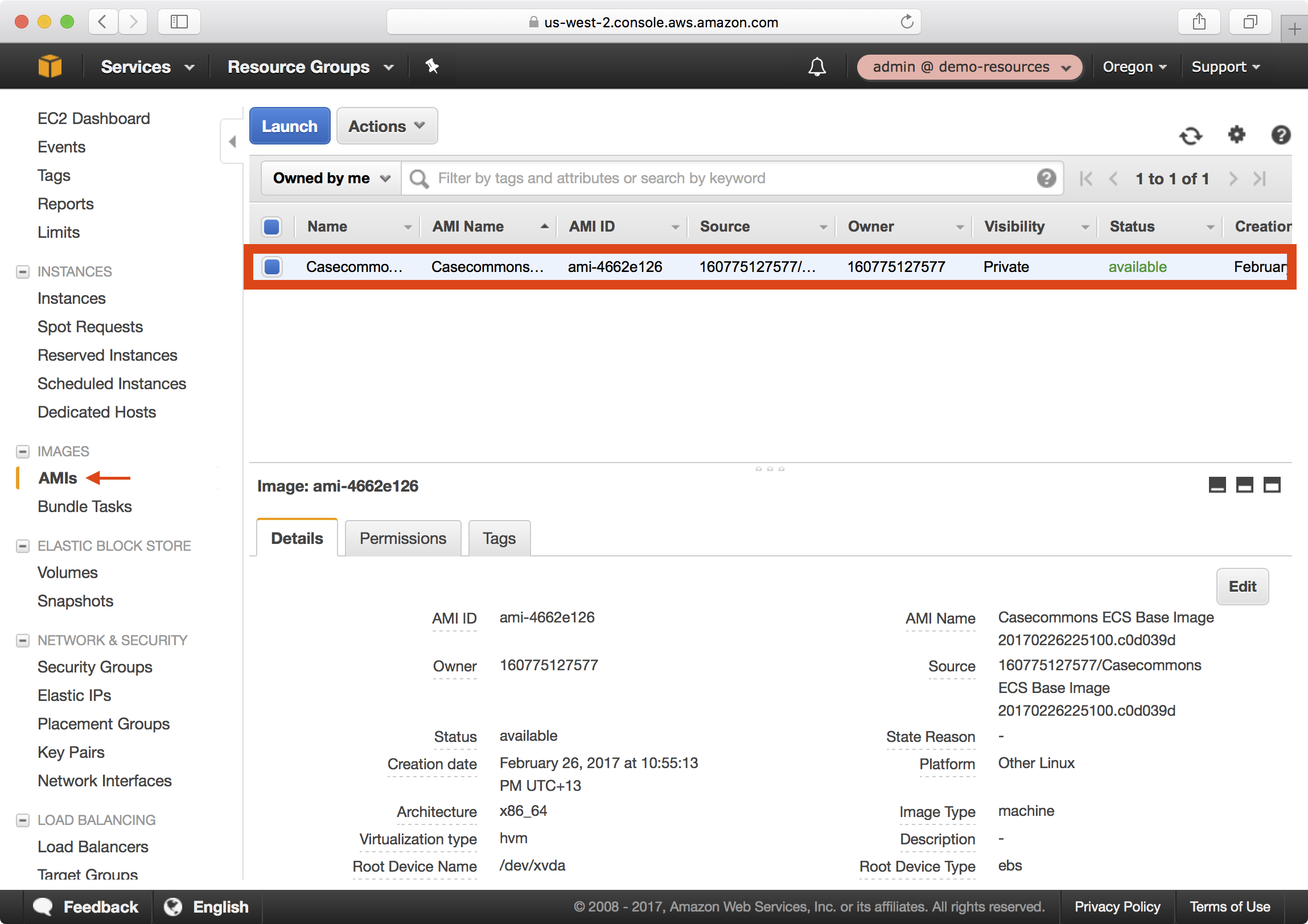
Notice that the AMI built in Step 3 is published and available in the demo-resources account.
Creating an EC2 Key Pair
The web proxy template requires an EC2 keypair name to be provided as an input, which will be granted SSH access to the ECS container instances created as part of the web proxy stack.
1. In the AWS console, navigate to EC2 > Network & Security > Key Pairs and click on the Create Key Pair button:
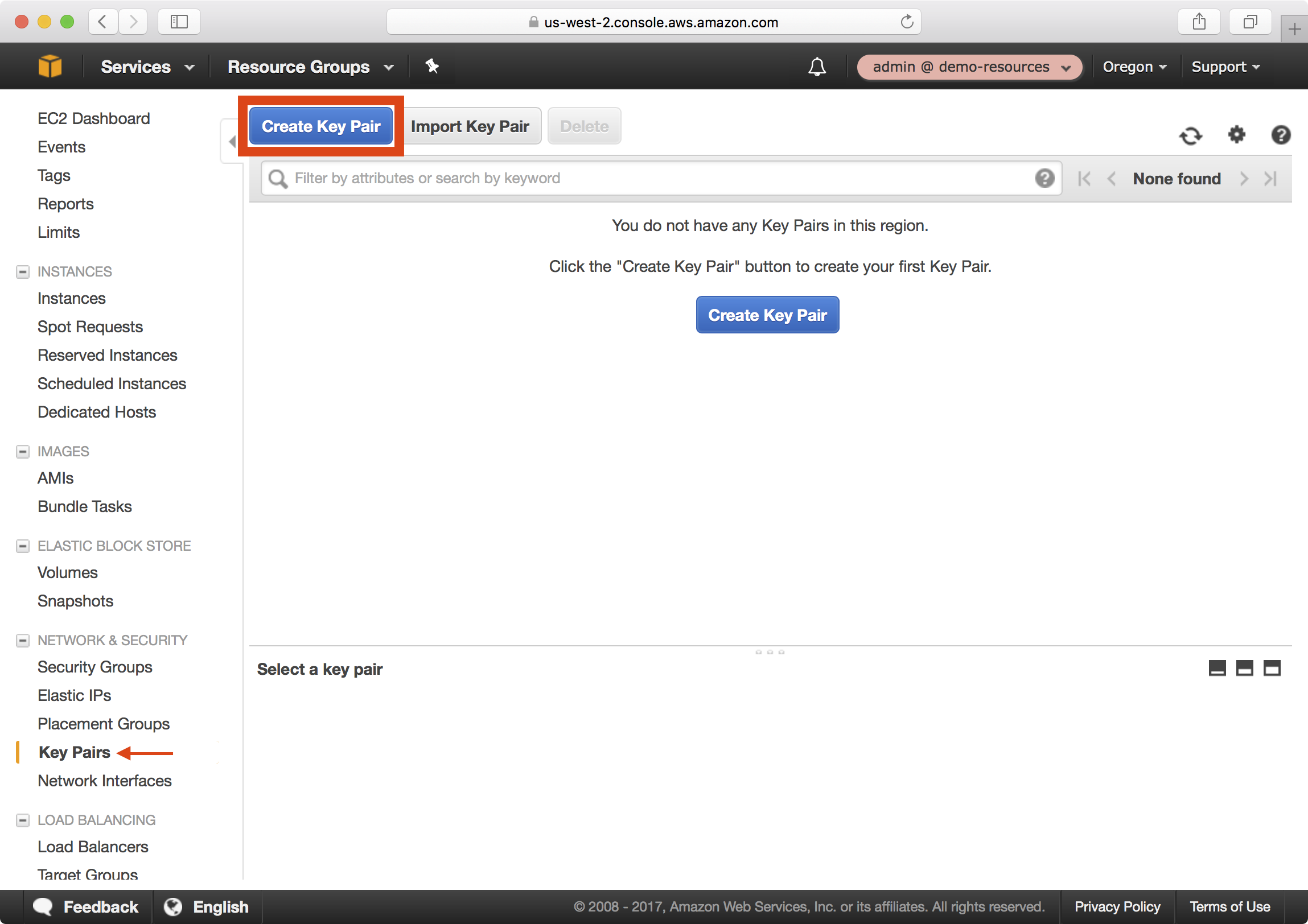
2. Name the key admin and click on the Create button.
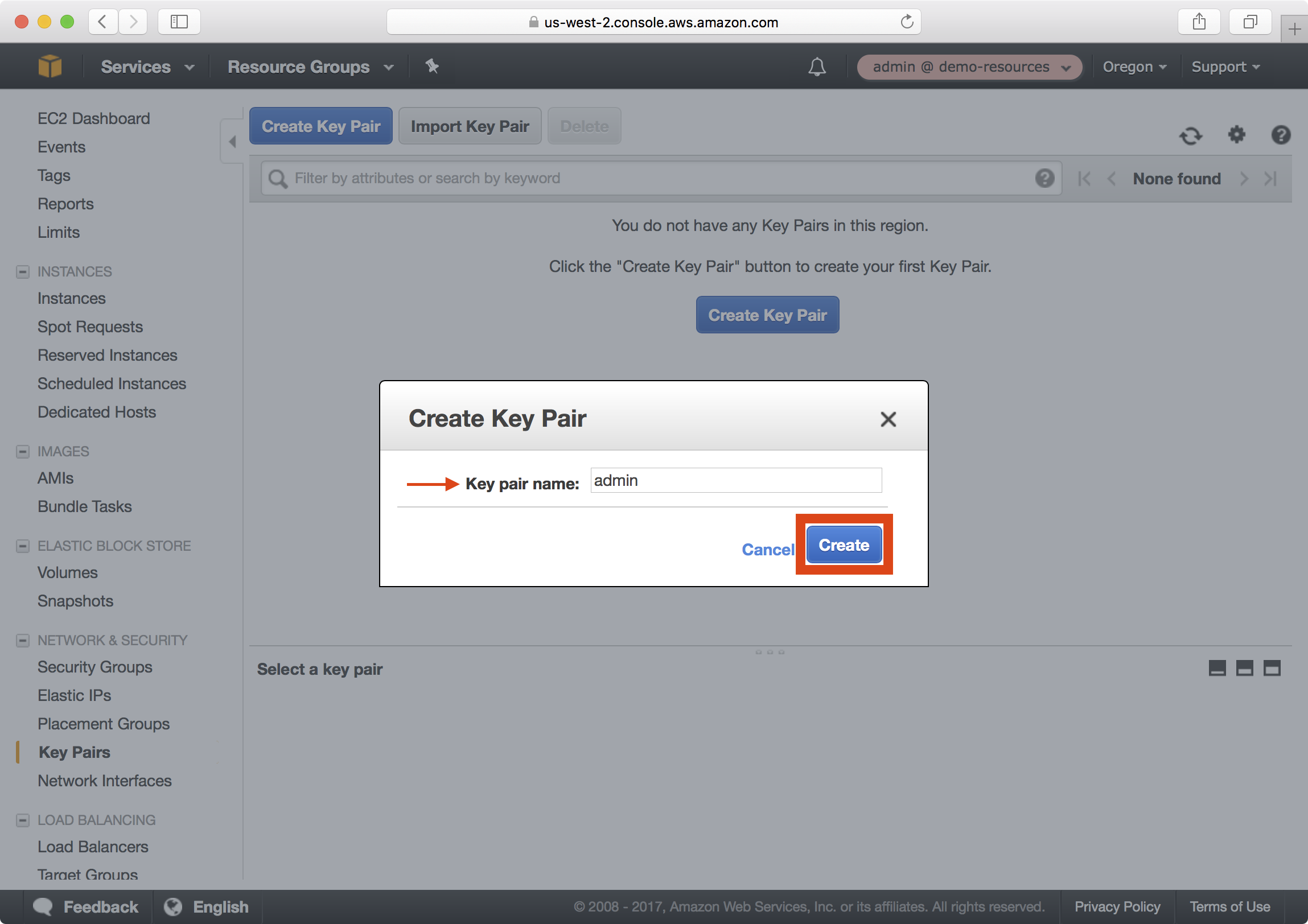
3. A new key pair is created and a SSH private key file is downloaded to your computer:
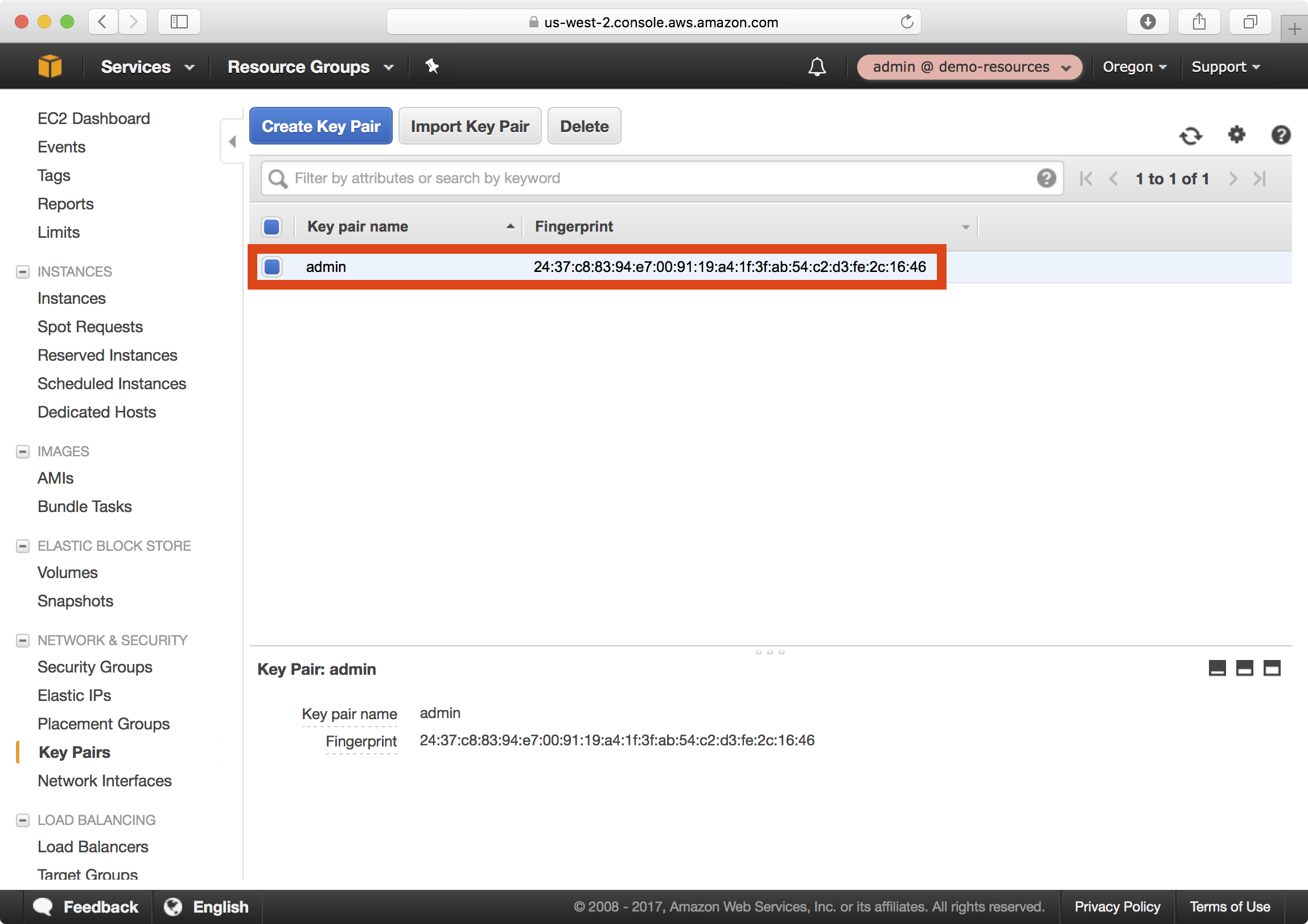
4. Move the SSH private key file to your ~/.ssh folder and ensure the required permissions are set:
$ mv ~/Downloads/admin.pem.txt ~/.ssh/demo-resources-admin.pem
$ chmod 600 ~/.ssh/demo-resources-admin.pem
Creating the Playbook
We can now get started establishing a proxy playbook that defines a proxy stack for the Demo Resources account.
1. Clone the AWS Starter to a local folder called demo-proxy and re-initialise the Git repository.
$ git clone git@github.com:casecommons/aws-starter.git demo-proxy
Cloning into 'demo-proxy'...
remote: Counting objects: 22, done.
remote: Compressing objects: 100% (14/14), done.
remote: Total 22 (delta 4), reused 22 (delta 4), pack-reused 0
Receiving objects: 100% (22/22), done.
Resolving deltas: 100% (4/4), done
$ cd demo-proxy
$ rm -rf .git
$ git init
Initialized empty Git repository in /Users/jmenga/Source/casecommons/demo-proxy/.git/
2. Update the roles/requirements.yml file to the desired versions for each role:
# You can specify git tag, commit or branch for the version property
- src: git@github.com:casecommons/aws-cloudformation.git
scm: git
version: 0.7.0
name: aws-cloudformation
- src: git@github.com:casecommons/aws-sts.git
scm: git
version: 0.1.2
name: aws-sts
3. Install the roles using the ansible-galaxy command as demonstrated below:
$ ansible-galaxy install -r roles/requirements.yml --force
- extracting aws-cloudformation to /Users/jmenga/Source/casecommons/demo-proxy/roles/aws-cloudformation
- aws-cloudformation was installed successfully
- extracting aws-sts to /Users/jmenga/Source/casecommons/demo-proxy/roles/aws-sts
- aws-sts was installed successfully
4. Modify the group_vars/all/vars.yml file, which contains global settings for the playbook:
# Stack Settings
cf_stack_name: web-proxy
cf_stack_template: "templates/proxy.yml.j2"
cf_stack_tags:
org:business:owner: Casecommons
org:business:product: Web Proxy
org:business:severity: High
org:tech:environment: "{{ env }}"
org:tech:contact: pema@casecommons.org
# Stack inputs
cf_stack_inputs:
ApplicationImageId: "{{ config_application_ami }}"
ApplicationInstanceType: "{{ config_application_instance_type }}"
ApplicationAutoscalingDesiredCount: "{{ config_application_desired_count | default(config_az_count) | default(2) | int }}"
KeyName: "{{ config_application_keyname }}"
Environment: "{{ env }}"
ProxyImage: "{{ config_proxy_image }}"
ProxyImageTag: "{{ config_proxy_tag }}"
ProxyDisableWhitelist: "{{ config_proxy_disable_whitelist | default(false) | string | lower }}"
ProxyWhitelist: "{{ config_proxy_whitelist | default('') }}"
Notice that we reference the templates/proxy.yml.y2 template that is embedded within the aws-cloudformation role.
We also add a dictionary called cf_stack_inputs, which provides values for input parameters defined in the proxy CloudFormation template.
Notice that these settings reference environment specific settings prefixed with config_, which will we need to define in our environment settings.
5. Remove the local templates folder, since we are using a template that is embedded within the aws-cloudformation role:
$ rm -rf templates
Defining a New Environment
We will now add a new environment called demo-resources to the playbook, which will be used to create CloudFormation resources in the demo-resources account.
1. Modify the inventory file so that it defines a single environment called demo-resources, ensuring you specify ansible_connection=local:
[demo-resources]
demo-resources ansible_connection=local
2. Remove the group_vars/non-prod environment folder that is included in the starter template:
$ rm -rf group_vars/non-prod
3. Create a file called group_vars/demo-resources/vars.yml, which will hold all environment specific configuration for the demo-resources environment:
$ mkdir -p group_vars/demo-resources
$ touch group_vars/demo-resources/vars.yml
4. Add the following settings to group_vars/demo-resources/vars.yml:
# STS role in the target AWS account to assume
sts_role_arn: "arn:aws:iam::160775127577:role/admin"
# Application settings
config_application_keyname: admin
config_application_instance_type: t2.micro
config_application_ami: ami-4662e126
config_az_count: 3
config_log_deletion_policy: Delete
# Proxy settings
config_proxy_image: 160775127577.dkr.ecr.us-west-2.amazonaws.com/casecommons/squid
config_proxy_tag: latest
config_proxy_disable_whitelist: false
config_proxy_whitelist: .demo.cloudhotspot.co
config_proxy_network_mode: host
Here we target the demo-resources account by specifying the demo-resources IAM admin role in the sts_role_arn variable, whilst the remaining settings configure the proxy template:
config_application_keyname- specifies the name of the EC2 key pair that ECS container instances will be created with. Notice this matches the name of the EC2 key pair created earlier.config_application_instance_type- specifies the EC2 instance type for the ECS container instances that will be created.config_application_ami- specifies the AMI ID of the image used to create the ECS container instances. Notice this matches the ID of the AMI created earlierconfig_az_count- specifies the number of availability zones to place ECS conatiner instances into.config_log_deletion_policy- specifies whether to “Delete” or “Retain” CloudWatch log groups when the stack is destroyed.config_proxy_image- specifies the Docker image used to run the squid proxy containers. Notice this matches the image created in EC2 Container Registry Resourcesconfig_proxy_tag- specifies the Docker image tag used to run the squid proxy containers.config_proxy_disable_whitelist- disables the web proxy whitelist when set totrue. The default setting isfalse.config_proxy_whitelist- defines domains that will be added to the web proxy whitelist. Here we add.demo.cloudhotspot.co, which means any host in*.demo.cloudhotspot.cowill be whitelisted.config_proxy_network_mode- configures the Docker networking mode - in this example it is set tohost, meaning the squid container will share the ECS container instance operating system network stack.
Note
The squid Docker image created in EC2 Container Registry Resources includes a whitelist that only permits access to AWS service API endpoints. See https://github.com/Casecommons/docker-squid#squid-whitelist for details on the default whitelist.
Running the Playbook
Now that we’ve defined environment settings for the demo-resources environment, let’s run the playbook to create ECR repository resources for the environment.
1. Ensure your local AWS environment is configured to target the demo-resources account:
$ export AWS_PROFILE=demo-resources-admin
2. Run the Ansible playbook targeting the demo-resources environment as demonstrated below:
$ ansible-playbook site.yml -e env=demo-resources
PLAY [Assume Role] *************************************************************
TASK [aws-sts : set_fact] ******************************************************
ok: [demo-resources]
TASK [aws-sts : checking if sts functions are sts_disabled] ********************
skipping: [demo-resources]
TASK [aws-sts : setting empty sts_session_output result] ***********************
skipping: [demo-resources]
TASK [aws-sts : setting sts_creds if legacy AWS credentials are present (e.g. for Ansible Tower)] ***
skipping: [demo-resources]
TASK [aws-sts : assume sts role] ***********************************************
Enter MFA code: ******
ok: [demo-resources]
...
...
TASK [aws-cloudformation : set local path fact if s3 upload disabled] **********
ok: [demo-resources]
TASK [aws-cloudformation : configure application stack] ************************
...
...
PLAY RECAP *********************************************************************
demo-resources : ok=20 changed=1 unreachable=0 failed=0
3. The playbook will take approxiately 10 minutes to create the CloudFormation stack and associated resources. Whilst the CloudFormation stack is being created, you can review the CloudFormation stack that was generated in the build/<timestamp> folder:
$ tree build
build
└── 20170227015822
├── web-proxy-config.json
├── web-proxy-policy.json
├── web-proxy-stack.json
└── web-proxy-stack.yml
The following shows the web-proxy-stack.yml file that was generated and uploaded to CloudFormation:
AWSTemplateFormatVersion: "2010-09-09"
Description: Squid Forward Proxy
Parameters:
ApplicationImageId:
Type: String
Description: Application Amazon Machine Image ID
ApplicationInstanceType:
Type: String
Description: Application EC2 Instance Type
ApplicationAutoscalingDesiredCount:
Type: Number
Description: Application AutoScaling Group Desired Count
Default: 3
ProxyImage:
Type: String
Description: Docker Image for Proxy
Default: 429614120872.dkr.ecr.us-west-2.amazonaws.com/cwds/squid
ProxyImageTag:
Type: String
Description: Docker Image Tag for Proxy
Default: latest
ProxyDisableWhitelist:
Type: String
Description: Disables whitelist when set to true. Proxy will operate as an open proxy.
Default: "false"
AllowedValues:
- "true"
- "false"
ProxyWhitelist:
Type: String
Description: Comma separated list of domains to whitelist
Default: ""
KeyName:
Type: String
Description: EC2 Key Pair for SSH Access
Environment:
Type: String
Description: Stack Environment
Resources:
ProxyDnsRecord:
Type: "AWS::Route53::RecordSet"
Properties:
Name:
Fn::Join: ["", [ "proxy.", "Fn::ImportValue": "DefaultVpcDomain" ] ]
TTL: "300"
HostedZoneName:
Fn::Join: ["", [ "Fn::ImportValue": "DefaultVpcDomain", "." ] ]
Type: "CNAME"
Comment:
Fn::Sub: "Forward Proxy - ${Environment}"
ResourceRecords:
- Fn::Sub: "${ApplicationLoadBalancer.DNSName}"
ApplicationLoadBalancer:
Type : "AWS::ElasticLoadBalancing::LoadBalancer"
Properties:
Scheme: "internal"
SecurityGroups:
- Ref: "ApplicationLoadBalancerSecurityGroup"
Subnets:
- Fn::ImportValue: "DefaultPublicSubnetA"
- Fn::ImportValue: "DefaultPublicSubnetB"
- Fn::ImportValue: "DefaultPublicSubnetC"
CrossZone: "true"
ConnectionSettings:
IdleTimeout: 120
ConnectionDrainingPolicy:
Enabled: "true"
Timeout: 120
Listeners:
- LoadBalancerPort: "3128"
InstancePort: "3128"
Protocol: "tcp"
Tags:
- Key: Name
Value:
Fn::Sub: ${AWS::StackName}-${Environment}-elb
ApplicationLoadBalancerSecurityGroup:
Type: "AWS::EC2::SecurityGroup"
Properties:
VpcId:
Fn::ImportValue: "DefaultVpcId"
GroupDescription: "Proxy Load Balancer Security Group"
SecurityGroupIngress:
- IpProtocol: "tcp"
FromPort: 3128
ToPort: 3128
CidrIp:
Fn::ImportValue: "DefaultVpcCidr"
ApplicationLoadBalancerToAutoscalingIngressTCP3128:
Type: "AWS::EC2::SecurityGroupIngress"
Properties:
IpProtocol: "tcp"
FromPort: 3128
ToPort: 3128
GroupId: { "Ref": "ApplicationAutoscalingSecurityGroup" }
SourceSecurityGroupId: { "Ref": "ApplicationLoadBalancerSecurityGroup" }
ApplicationLoadBalancerToAutoscalingEgressTCP3128:
Type: "AWS::EC2::SecurityGroupEgress"
Properties:
IpProtocol: "tcp"
FromPort: 3128
ToPort: 3128
GroupId: { "Ref": "ApplicationLoadBalancerSecurityGroup" }
DestinationSecurityGroupId: { "Ref": "ApplicationAutoscalingSecurityGroup" }
ApplicationAutoscaling:
Type: "AWS::AutoScaling::AutoScalingGroup"
DependsOn:
- DmesgLogGroup
- DockerLogGroup
- EcsAgentLogGroup
- EcsInitLogGroup
- MessagesLogGroup
CreationPolicy:
ResourceSignal:
Count: { "Ref": "ApplicationAutoscalingDesiredCount"}
Timeout: "PT15M"
UpdatePolicy:
AutoScalingRollingUpdate:
MinInstancesInService: { "Ref": "ApplicationAutoscalingDesiredCount"}
MinSuccessfulInstancesPercent: "100"
WaitOnResourceSignals: "true"
PauseTime: "PT15M"
Properties:
VPCZoneIdentifier:
- Fn::ImportValue: "DefaultPublicSubnetA"
- Fn::ImportValue: "DefaultPublicSubnetB"
- Fn::ImportValue: "DefaultPublicSubnetC"
LaunchConfigurationName: { "Ref" : "ApplicationAutoscalingLaunchConfiguration" }
MinSize: "0"
MaxSize: "4"
DesiredCapacity: { "Ref": "ApplicationAutoscalingDesiredCount" }
Tags:
- Key: Name
Value:
Fn::Sub: ${AWS::StackName}-instance
PropagateAtLaunch: "true"
ApplicationAutoscalingLaunchConfiguration:
Type: "AWS::AutoScaling::LaunchConfiguration"
Metadata:
AWS::CloudFormation::Init:
config:
commands:
10_first_run:
command: "sh firstrun.sh"
env:
STACK_NAME: { "Ref": "AWS::StackName" }
AUTOSCALING_GROUP: "ApplicationAutoscaling"
AWS_DEFAULT_REGION: { "Ref": "AWS::Region" }
ECS_CLUSTER: { "Ref": "ApplicationCluster" }
DOCKER_NETWORK_MODE: "host"
cwd: "/home/ec2-user/"
files:
/etc/ecs/ecs.config:
content:
Fn::Sub: "ECS_CLUSTER=${ApplicationCluster}\n"
Properties:
ImageId: { "Ref": "ApplicationImageId" }
InstanceType: { "Ref": "ApplicationInstanceType" }
AssociatePublicIpAddress: "true"
IamInstanceProfile: { "Ref": "ApplicationAutoscalingInstanceProfile" }
KeyName: { "Ref": "KeyName" }
SecurityGroups:
- Ref: "ApplicationAutoscalingSecurityGroup"
UserData:
Fn::Base64:
Fn::Join: ["\n", [
"#!/bin/bash",
"set -e",
"Fn::Sub": "/opt/aws/bin/cfn-init -v --stack ${AWS::StackName} --resource ApplicationAutoscalingLaunchConfiguration --region ${AWS::Region}",
"Fn::Sub": "/opt/aws/bin/cfn-signal -e $? --stack ${AWS::StackName} --resource ApplicationAutoscaling --region ${AWS::Region}"
] ]
ApplicationAutoscalingSecurityGroup:
Type: "AWS::EC2::SecurityGroup"
Properties:
VpcId:
Fn::ImportValue: "DefaultVpcId"
GroupDescription: "Proxy Security Group"
SecurityGroupIngress:
- IpProtocol: "tcp"
FromPort: 22
ToPort: 22
CidrIp:
Fn::ImportValue: "DefaultManagementSubnetACidr"
- IpProtocol: "tcp"
FromPort: 22
ToPort: 22
CidrIp:
Fn::ImportValue: "DefaultManagementSubnetBCidr"
SecurityGroupEgress:
- IpProtocol: "tcp"
FromPort: 80
ToPort: 80
CidrIp: 0.0.0.0/0
- IpProtocol: "tcp"
FromPort: 443
ToPort: 443
CidrIp: 0.0.0.0/0
- IpProtocol: "udp"
FromPort: 53
ToPort: 53
CidrIp:
Fn::Join: ["", [
"Fn::ImportValue": "DefaultVpcDnsServer", "/32"
] ]
- IpProtocol: "udp"
FromPort: 123
ToPort: 123
CidrIp: 0.0.0.0/0
ApplicationAutoscalingRole:
Type: "AWS::IAM::Role"
Properties:
AssumeRolePolicyDocument:
Version: "2012-10-17"
Statement:
- Effect: "Allow"
Principal:
Service: [ "ec2.amazonaws.com" ]
Action: [ "sts:AssumeRole" ]
Path: "/"
ManagedPolicyArns: []
Policies:
- {"PolicyName": "CloudWatchLogs", "PolicyDocument": {"Version": "2012-10-17", "Statement": [{"Action": ["logs:CreateLogGroup", "logs:CreateLogStream", "logs:PutLogEvents", "logs:DescribeLogStreams"], "Resource": {"Fn::Sub": "arn:aws:logs:${AWS::Region}:${AWS::AccountId}:log-group:${AWS::StackName}*"}, "Effect": "Allow"}]}}
- PolicyName: "EC2ContainerInstancePolicy"
PolicyDocument:
Statement:
- Effect: "Allow"
Action:
- "ecs:RegisterContainerInstance"
- "ecs:DeregisterContainerInstance"
Resource:
Fn::Sub: "arn:aws:ecs:${AWS::Region}:${AWS::AccountId}:cluster/${ApplicationCluster}"
- Effect: "Allow"
Action:
- "ecs:DiscoverPollEndpoint"
- "ecs:Submit*"
- "ecs:Poll"
- "ecs:StartTelemetrySession"
Resource: "*"
- Effect: "Allow"
Action:
- "ecr:BatchCheckLayerAvailability"
- "ecr:BatchGetImage"
- "ecr:GetDownloadUrlForLayer"
- "ecr:GetAuthorizationToken"
Resource: "*"
ApplicationAutoscalingInstanceProfile:
Type: "AWS::IAM::InstanceProfile"
Properties:
Path: "/"
Roles: [ { "Ref": "ApplicationAutoscalingRole" } ]
ApplicationCluster:
Type: "AWS::ECS::Cluster"
ApplicationTaskDefinition:
Type: "AWS::ECS::TaskDefinition"
Properties:
NetworkMode: "host"
ContainerDefinitions:
- Name: squid
Image:
Fn::Sub: ${ProxyImage}:${ProxyImageTag}
Memory: 995
LogConfiguration:
LogDriver: awslogs
Options:
awslogs-group:
Fn::Sub: ${AWS::StackName}/ecs/ProxyService/squid
awslogs-region: { "Ref": "AWS::Region" }
PortMappings:
- ContainerPort: 3128
Protocol: tcp
Environment:
- Name: NO_WHITELIST
Value: { "Ref": "ProxyDisableWhitelist" }
- Name: SQUID_WHITELIST
Value: { "Ref": "ProxyWhitelist" }
ProxyService:
Type: "AWS::ECS::Service"
DependsOn:
- ApplicationAutoscaling
- ProxyServiceLogGroup
Properties:
Cluster: { "Ref": "ApplicationCluster" }
TaskDefinition: { "Ref": "ApplicationTaskDefinition" }
DesiredCount: { "Ref": "ApplicationAutoscalingDesiredCount"}
DeploymentConfiguration:
MinimumHealthyPercent: 50
MaximumPercent: 200
LoadBalancers:
- ContainerName: "squid"
ContainerPort: "3128"
LoadBalancerName: { "Ref": "ApplicationLoadBalancer" }
Role: { "Ref": "EcsServiceRole" }
EcsServiceRole:
Type: "AWS::IAM::Role"
Properties:
AssumeRolePolicyDocument:
Version: "2012-10-17"
Statement:
- Effect: "Allow"
Principal:
Service: [ "ecs.amazonaws.com" ]
Action: [ "sts:AssumeRole" ]
Path: "/"
ManagedPolicyArns:
- "arn:aws:iam::aws:policy/service-role/AmazonEC2ContainerServiceRole"
DmesgLogGroup:
Type: "AWS::Logs::LogGroup"
DeletionPolicy: "Delete"
Properties:
LogGroupName:
Fn::Sub: ${AWS::StackName}/ec2/ApplicationAutoscaling/var/log/dmesg
RetentionInDays: 30
DockerLogGroup:
Type: "AWS::Logs::LogGroup"
DeletionPolicy: "Delete"
Properties:
LogGroupName:
Fn::Sub: ${AWS::StackName}/ec2/ApplicationAutoscaling/var/log/docker
RetentionInDays: 30
EcsAgentLogGroup:
Type: "AWS::Logs::LogGroup"
DeletionPolicy: "Delete"
Properties:
LogGroupName:
Fn::Sub: ${AWS::StackName}/ec2/ApplicationAutoscaling/var/log/ecs/ecs-agent
RetentionInDays: 30
EcsInitLogGroup:
Type: "AWS::Logs::LogGroup"
DeletionPolicy: "Delete"
Properties:
LogGroupName:
Fn::Sub: ${AWS::StackName}/ec2/ApplicationAutoscaling/var/log/ecs/ecs-init
RetentionInDays: 30
MessagesLogGroup:
Type: "AWS::Logs::LogGroup"
DeletionPolicy: "Delete"
Properties:
LogGroupName:
Fn::Sub: ${AWS::StackName}/ec2/ApplicationAutoscaling/var/log/messages
RetentionInDays: 30
ProxyServiceLogGroup:
Type: "AWS::Logs::LogGroup"
DeletionPolicy: "Delete"
Properties:
LogGroupName:
Fn::Sub: ${AWS::StackName}/ecs/ProxyService/squid
RetentionInDays: 30
Outputs:
ProxyURL:
Description: "Squid Proxy URL"
Value:
Fn::Join: ["", [
"http://proxy.",
"Fn::ImportValue": "DefaultVpcDomain",
":3128"
] ]
Export:
Name: "DefaultProxyURL"
ProxySecurityGroup:
Description: "Squid Proxy Security Group"
Value:
Ref: ApplicationLoadBalancerSecurityGroup
Export:
Name: "DefaultProxySecurityGroup"
4. Once the playbook execution completes successfully, login to the demo-resources account. You should see a new CloudFormation stack called web-proxy:
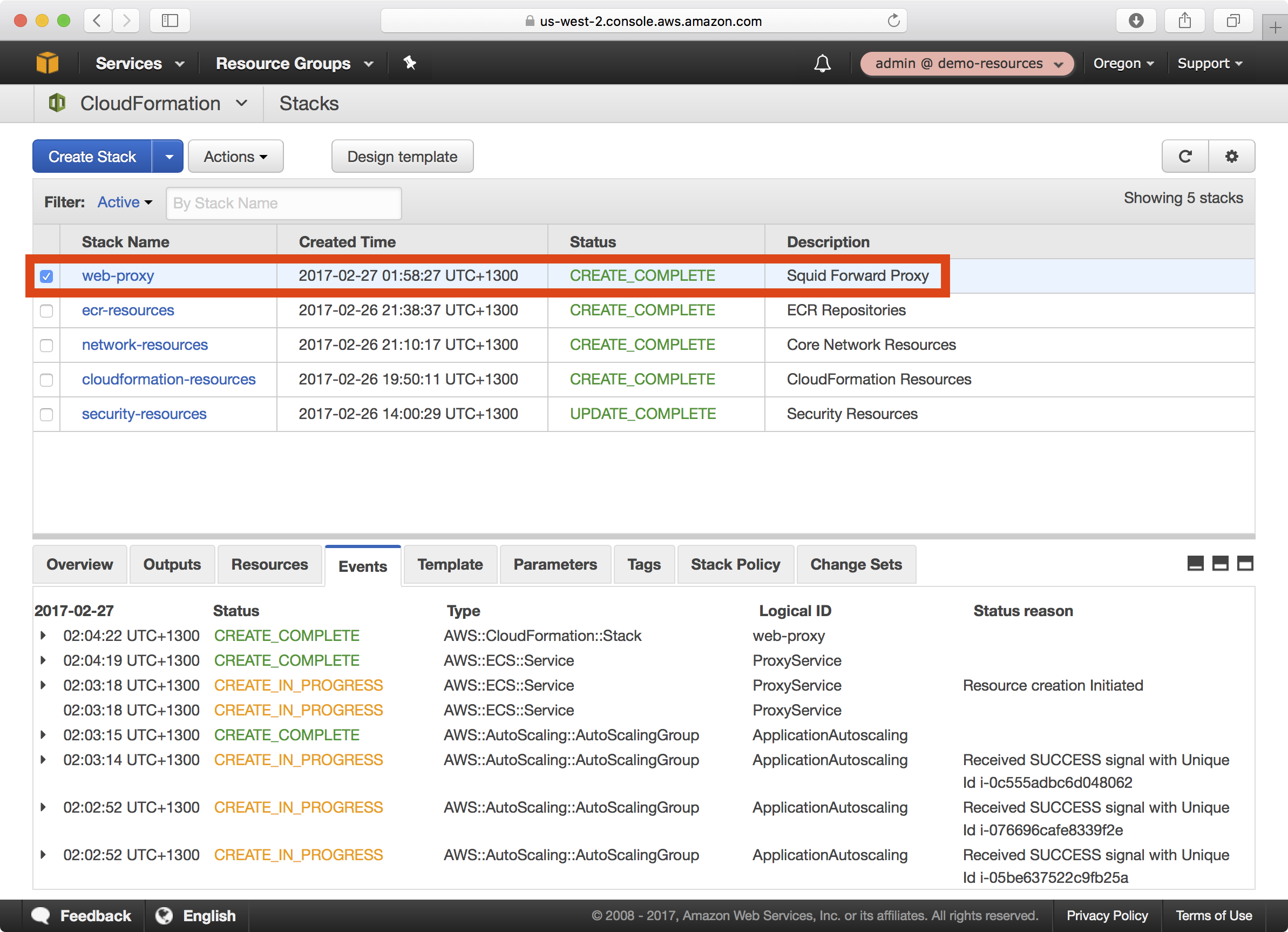
5. If you open the ECS dashboard and select Clusters, you can see a single ECS cluster was created:
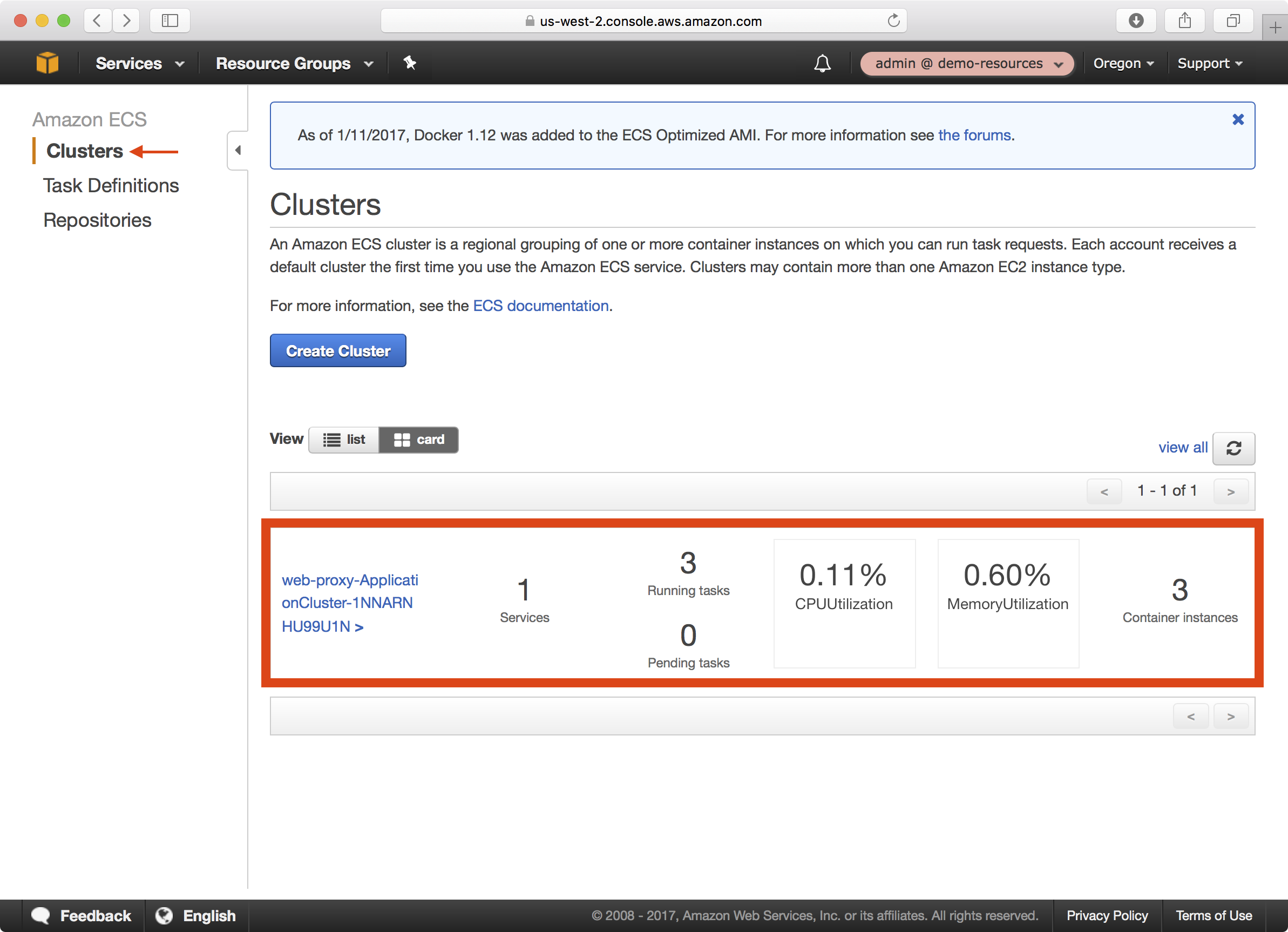
Wrap Up
We created a web proxy in our demo-resources account, which provides the ability for hosts located on private subnets to be able to communicate securely with AWS APIs.
Note
At this point you should commit your changes to the web proxy playbook before continuing.